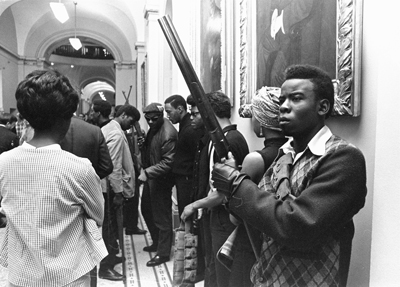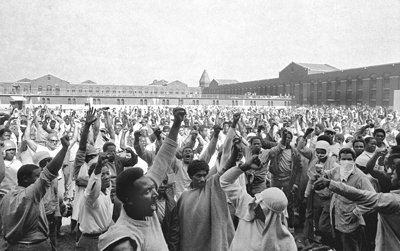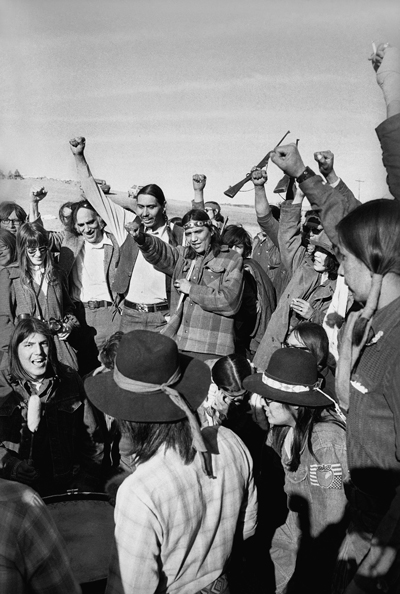Many people on both the left and the right of the political spectrum believe that "the law is the law, and is the same for everybody". This, of course, is total bullshit. The laws were written to uphold the status quo and their system, and if you threaten their way of life, you will be incarcerated and worse.
This also explains why white supremacists and other brainless scum get treated differently than those who are protesting against police brutality.
This also explains why white supremacists and other brainless scum get treated differently than those who are protesting against police brutality.
On the white supremacist occupation in Oregon:
Kid Gloves for Fascists—Iron Fist for the Oppressed
January 12, 2016 | Revolution Newspaper | revcom.us
From a reader:
On January 2, a heavily armed group of fascist white supremacists took over the headquarters of Malheur National Wildlife Refuge near Burns, Oregon, and occupied its central building. Contrast the “hands off” approach of the system to this incident in Oregon with the violent repression of the Occupy movement, to take just one recent example. And as many people have pointed out, if a group of armed Black, Native American, or Latino people occupied federal property—or anything else—they would be attacked with vicious, overwhelming force by the government. No need to wonder if that’s true. In fact that has happened over and over. Following are three examples of the legal display of weapons, or use of weapons in legitimate self-defense against government violence, resulted in ferocious attacks by the system. As we go to press, this occupation continues and it is not clear what the outcome will be, but it is clear that up to now the government has given these fascists a lot of space to do what they want to do.
Sacramento, 1967
In 1967 the Black Panther Party launched armed patrols of Oakland’s ghettos, to monitor and observe brutalizing, murdering police. The Panthers openly carried guns, in compliance with California law. California’s political leaders, including Governor Ronald Reagan, responded with a proposed law outlawing the open carry of firearms in the state.
On May 2, 1967, 30 Black Panthers in leather jackets and berets—24 men and 6 women—walked into the California State Capitol in Sacramento carrying rifles, shotguns, and handguns, pointed upward. Legislators scrambled to leave the building, or hide under their desks. In response to a reporter’s question, 16-year-old Panther Bobby Hutton replied, “We’re the Black Panthers. We’re Black people with guns. What about it?”
Five Panthers were arrested outside the state capitol that day on felony charges of “conspiracy to disrupt a legislative session”. The State of California soon passed a law known as the “Panther bill” that outlawed open carry of guns. Throughout the country, the Panthers came under ferocious attack by the police at every level of government for the next several years. Panthers were victims of police beatings, spying, break-ins, fabricated setups, and outright murder. Bobby Hutton was murdered by Oakland police less than one year after the Sacramento action.
Attica, New York, 1971
Attica prison in upstate New York was built to hold 1,600 men but by 1971 the prison population was over 2,200, 54 percent Black, 9 percent Puerto Rican, 37 percent white. It was a hellhole of racist brutality, routine beatings, denial of medical care. On September 9, 1971, 1,200 Attica prisoners seized control of half the prison, taking 38 prison guards hostage. For four days, the Attica Brothers controlled D-yard, issuing a call to people on the outside to witness the brutal nature of the system and support their stand.
The Attica Brothers formed a leadership and negotiating committee made up of Black, Latino, and white prisoners. Among the prisoners as a whole, there was an unbreakable unity. They were highly organized and disciplined. Despite the fact that they had suffered under the sadistic prison guards, they gave their hostages decent living quarters, food rations and set up a security force to protect them.
On September 13, at the order of Governor Nelson Rockefeller, who had ignored the prisoners’ demand for a meeting, 211 state troopers and corrections officers retook Attica using tear gas, rifles, and shotguns. After the shooting was over, 10 hostages and 29 inmates lay dead or dying. At least 3,000 rounds of ammunition had been discharged. Prison officials initially said the hostages had been killed by the prisoners. But pathology reports later revealed that all hostages and inmates died from gunshot wounds. None of the prisoners had had any guns.
Wounded Knee, South Dakota, 1973
In the spring of 1973, hundreds of Indian people and their supporters occupied the village of Wounded Knee on the Pine Ridge Indian Reservation in South Dakota. They demanded an end to the U.S. government-backed murder and intimidation of American Indian Movement (AIM) supporters on the reservation. They demanded that treaties signed by the U.S. that gave the Lakota people (also known as the Sioux) the right to self-rule and to the land surrounding the Black Hills be honored.
Federal authorities surrounded them with an army of over 300. The Indians refused to back down. They used weapons to defend themselves and held off the government forces for 73 days. The courage and militancy of the fighters at Wounded Knee grabbed the attention of people all over the world and helped build powerful support for the struggle of Native peoples. Wounded Knee—the site of the 1890 massacre of 300 Sioux men, women, and children—became a symbol of renewed Indian struggle and resistance.
After this siege, the U.S. government unleashed an intense, murderous repression against the people of Pine Ridge. AIM members came to the reservation from all over the U.S. to support the struggle. It was as part of this AIM mobilization that Leonard Peltier came onto the Pine Ridge Reservation in 1975.
On June 26, 1975, in an FBI raid on the AIM camp at Oglala, two FBI agents and one AIM activist were killed. In 1977 Peltier was framed for the murder of the agents and railroaded into prison. He is still in a federal prison and is respected around the world as a voice for Native people and an inspiring political prisoner who refuses to be broken.



